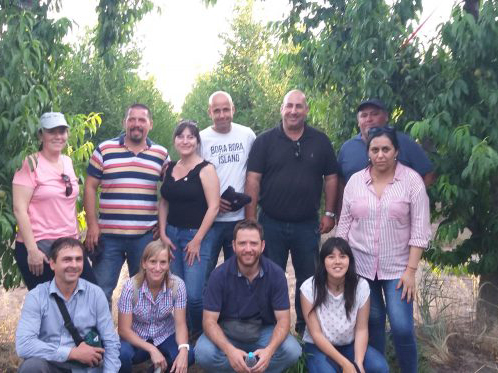In Mendoza and San Rafael, Argentina, and between December 4 and 6, a new activity was held of the Node of prunes of export, and attended by representatives of Agricultural and exporters participating in this node, highlighting Agricultural Mayor, Agricultural Los Castores, Agricultural Santa Elena, Agricultural El Tranque, Agricultural San Francisco, Frutexsa, Prunesco Pacific and Nut.
This project financed by Corfo Metropolitana, administered by Asoex and implemented by Chile Prunes aimed to hold various meetings with authorities and farmers, as well as visiting orchards and dryers (both in the sun and in the oven). Some key meetings were with the Mendoza Institute of Rural Development (IDR), where harvest forecasting methodologies were known; and the National Institute of Agricultural Technology (INTA), knowing in detail the work they do in the area of agricultural support, the processing and promotion of prunes in Argentina.
“I want to highlight the enthusiasm generated by the Chilean industry in that country, reflected that in the visits made, about 10, there were not only the owners, but representatives of neighboring or adjoining orchards. There is a lot of interest in hearing the voice of Chilean professionals, knowing their experience and how things are done in Chile,” says María Paz Soto, executive director of Chile Prunes.
Juan Horn of Agricultural San Francisco, emphasizes that it has been very beneficial to know the reality of the area of San Rafael to produce prunes (and other species), know contacts to be able to access research and suppliers of machinery, as well as learn about themes of fruit drying “where they outperform us in what is gas dryer management , not only because of having low-cost natural gas, but INTA, does research to make this process more efficient.” It also, he says, allowed to project harvest and volume to decide how to market our fruit this year (volume of sale in fresh and dry).
Similarly, Pablo Campino of Pacific Nut, who has perceived that this trip has been very beneficial to both Chileans and the Argentine counterpart, transferring knowledge and experiences is manifest. “They have a complex climate, with hail and frost, as well as a Water deficit similar to Chile, but with the difference that we have the 80-90 of the orchards with technified irrigation, while they are just starting and they are in a 10”. However, he points out, the one with 9,000 hectares planted attracts attention in such a complex and uncertain climatic zone, but where the land is cheaper and margins can be obtained that allow to find a good business.
Pablo Campino was also struck by the appearance that there seemed to be no joint line of work between the different sectors, with more unified work guides, where in the end it seemed that each beat them on his own, with much misinformation that led, for example, to some pruning in green.
Horn said something similar noting that there is still much to do in collaborative work between the different actors in order to standardize practices and adopt working techniques such as foliar or soil analysis that allow to guide and optimize their efforts.
Finally, the representatives of various agricultural farmers of Frutexsa of the south, Alejandra Moya (Santa Elena), Julio Lazo (El Tranque) and Pamela Oyarzun (Los Castores), point out that “as a company we had the opportunity to analyze, assimilate and contrast the reality that occurs outside our country. It was a great opportunity that allowed us to understand the importance of technical and/or professional support when planning an agricultural year and its tasks whether pruning, phytosanitary applications, fertilization among others.” Personally, they say agree that the most interesting thing was to know their screenings for the coming season. “We are very interested in the management they perform on their ‘farms’ and contrast with what we do, they are instances of learning.”




